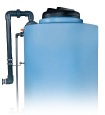Citric acid is a chemical commonly used in a number of different beverages and drinks as a flavoring and preservative. It can also be found in some household cleaners. Safe citric acid storage isn’t necessarily a major challenge, but there are a few things you must keep in mind in order to make certain that you’re storing citric acid properly.
Topics:
Chemicals,
Chemical Storage
Proper chemical storage is an important aspect of operating a plant or facility. In order to ensure that your chemicals are stored safely in polyethylene tanks, you need to choose a tank with the correct wall thickness. A fraction of an inch can make the difference between a tank that lasts for decades and one that fails early. Here’s what you need to know about determining the correct wall thickness for your chemical storage tank.
Topics:
Tank Design and Materials
Properly storing chemicals also means completely draining your storage tanks. Your regular maintenance and cleaning routine must include fully draining your chemical tanks to prevent contaminating new batches. But sometimes, draining the tank is easier said than done. Space constraints, incorrect fitting placements, and dealing with hazardous chemicals can all complicate routine maintenance.
Topics:
Tank Design and Materials
Stainless steel has long been the tank material of choice for storage in the food and beverage industry. Businesses have been hesitant to use polyethylene storage solutions, believing the porous resins would allow leaching and bacterial growth. Poly Processing’s innovative OR-1000™ system gives you an alternative option to expensive steel tanks. Our advanced polyethylene resin technology is fully FDA/CFR compliant, giving you a storage solution with longevity and cost savings advantages for food and beverage operations.
Topics:
Applications
Since 2015, the number of breweries in the U.S. has increased by almost 50% to over 5,500 breweries. As the industry becomes more crowded, the competition among beer makers is also increasing. That means craft breweries need to find more cost-effective ways to scale their business. Stainless steel tanks are the traditional choice for storing the materials for making beer. But innovative breweries are beginning to realize the business benefits of polyethylene storage tanks.
Topics:
Chemical Storage
There’s more to chemical storage tank colors than you might expect. When you purchase a Poly Processing tank from the catalog, you can select an unpainted translucent tank or a black tank. But many of our customers want to know if they can order a custom color for aesthetic reasons or branding purposes. If you need a custom color for your tank, you have a couple of options—some are better than others.
Topics:
Value Added
A tank pad, or housekeeping pad, provides some elevation above the containment berm so that plumbing can be fitted to the bottom of a chemical storage tank. Housekeeping pads are popular with our customers, but you need to be sure you plan correctly to get the best use out of them.
Topics:
Value Added
Sodium chloride brine is used in a variety of industrial applications. Auto manufacturers, system OEM’s, food processors, municipalities, refineries, hotels, hospitals, commercial laundries, textile dyeing houses, and chemical plants all use brine in their operations.
Topics:
Chemicals
Safe and effective chemical storage is expensive, and it might be tempting to purchase a chemical storage system without the added cost of a solid warranty, or with no warranty at all. The problem with that approach is that it might actually cost more in the long term to pay for expensive replacements and repairs.
Topics:
Value Added
Get ready to kick off 2018 safely! Every polyethylene chemical storage tank, regardless of its age, should be inspected at least once a year. Conducting a careful and thorough visual inspection assures the safety of employees, protects the integrity of the chemicals stored, and helps extend the life of the tank.
Topics:
Value Added



